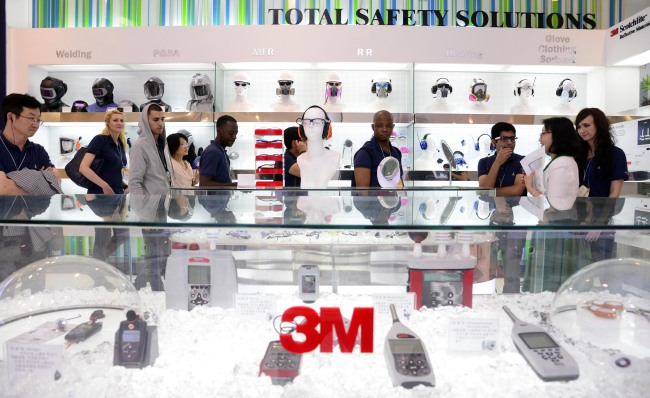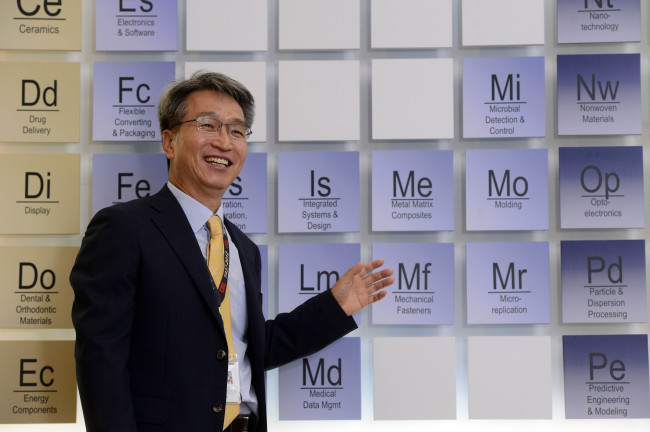3M Korea readies for future challenges through innovation
By Korea HeraldPublished : July 29, 2013 - 19:20

Following is the fourth in a series of articles about promising foreign-invested companies. ― Ed.
HWASEONG, Gyeonggi Province ― Constantly changing business environments and industry trends may present fear and uncertainty for some companies, often leading to their demise.
In fact, change occurs so rapidly nowadays that a whole industry may become defunct in a matter of time if businesses are not well prepared, vice president of 3M Korea and head of 3M Innovation Center Kim Chi-deuk told The Korea Herald.
“3M Korea, on the other hand, welcomes changes and challenges. In fact, our company thrives on the idea of innovation and we have been putting this concept into practice.”
HWASEONG, Gyeonggi Province ― Constantly changing business environments and industry trends may present fear and uncertainty for some companies, often leading to their demise.
In fact, change occurs so rapidly nowadays that a whole industry may become defunct in a matter of time if businesses are not well prepared, vice president of 3M Korea and head of 3M Innovation Center Kim Chi-deuk told The Korea Herald.
“3M Korea, on the other hand, welcomes changes and challenges. In fact, our company thrives on the idea of innovation and we have been putting this concept into practice.”

Since 1977, when 3M was first established here in Korea through a joint venture with Doosan Group, its local business operations have expanded significantly.
Moreover, as the U.S.-based multinational conglomerate decided to buy all the shares that Doosan Group held in it in 1996, the management and marketing arms of 3M Korea became more solid, according to company officials.
Despite its history in Korea, however, the level of consumer awareness of the company is often only in relation to its Scotch Tape brand.
“In fact, the sales of our household and stationary products ― such as Post-it, rubber gloves and cleaning products ― account for only about seven percent of 3M Korea’s total profit every year,” Kim explained.
“About 90 percent of our product lineup is for business-to-business operations.”
According to Kim, 3M Korea generated approximately 44 percent of its profits last year from its new products developed within the past five years.
3M’s range of products as well as the scope of industry coverage can be mind-blowing to ordinary consumers both here in Korea and worldwide, to say the least.
Formerly known as the Minnesota Mining and Manufacturing Company, it now produces more than 55,000 products available for purchase in some 196 countries, and employs about 84,000 people throughout the world.
Among some 70 international branches, 3M Korea currently ranks fifth, with last year’s sales revenue reaching nearly 1.6 trillion won ($1.4 billion) and operating profit hitting 170 billion won, according to the company.
Compared to other branches, 3M Korea has placed more emphasis on localization ― from sourcing raw materials to manufacturing and even appointing a Korean national to serve as president two years ago.
“Strategically, maintaining a close relationship with Korean electronics and automobile giants, such as Samsung, LG and Hyundai, is important,” Kim said.
“In fact, the making of the current liquid-crystal display panels would have been impossible without 3M first looking into dual-brightness enhancement film some 20 years ago.”
The film is currently used in a wide range of products such as laptop screens, automotive and avionic display panels, handheld devices and TVs, according to the company.
The most innovative product invented by 3M Korea is the clear adhesive applied in multiple layers on smartphone touch screen displays, Kim said.
In many ways, 3M Korea has acted as a bridge between large corporations and small- and medium-sized companies in Korea.
“Our company vision is to help advance companies of all sizes that we work with, and by doing so, assisting our domestic companies to compete better on the global stage.”
With that in mind, giving back to society and making genuine contributions to the local economy have also become integral parts of 3M Korea’s business operations.
The company invests about 5 billion won and hires some 40 new researchers annually, especially for research and development at the 3M Innovation Center.
“Our employees are our biggest assets. Every researcher at 3M Korea on average files one to two patents a year, which amount to a total of more than 200 patents annually,” Kim said.
Some of the locally invented products that are now widely in use globally include EMI/EMC solutions for electronics.
Behind this steady drive for innovation stands 3M Innovation Center.
Originally established in Suwon, Gyeonggi Province in 1991, in order not only to develop locally oriented products but also to foster a culture of competency for innovation, the center is often visited by diverse groups of industry leaders and public officials, according to the company.
LG Group CEO Koo Bon-moo, for example, visited 3M Innovation Center in 2011 with some 35 company executives.
Medical doctors and police officers also visit regularly for product demonstrations, the company said.
“About 90 percent of stethoscopes used by doctors here in Korea are 3M brand, and we produce a whole range of industrial safety ware, from dust masks to helmets and safety jackets,” Kim said.
“Health care, renewable energy and life sciences are also important areas into which 3M Korea has already started venturing.”
While taking advantage of its global brand power, 3M Korea is expected to start generating 70 percent of its revenue from the sales of locally-developed products starting in 2020, the company said.
According to Korea Trade-Investment Promotion Agency official Kim Myung-soo, increasing cooperation between domestic companies and foreign-invested companies such as 3M Korea is expected to generate synergy for more technological innovation in the coming years.
-
Articles by Korea Herald





![[KH Explains] No more 'Michael' at Kakao Games](http://res.heraldm.com/phpwas/restmb_idxmake.php?idx=644&simg=/content/image/2024/04/28/20240428050183_0.jpg&u=20240428180321)




![[Grace Kao] Hybe vs. Ador: Inspiration, imitation and plagiarism](http://res.heraldm.com/phpwas/restmb_idxmake.php?idx=644&simg=/content/image/2024/04/28/20240428050220_0.jpg&u=)









